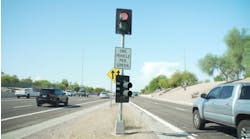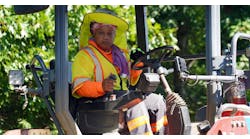By: Imran Hayee, Ph.D.
Growing traffic on U.S. roadways and heavy construction machinery in road work zones pose a critical safety threat to construction workers.
Each year more than 20,000 workers are injured in work-zone accidents involving heavy machinery or passing traffic. From 2004 to 2013, work-zone deaths averaged 773 per year, of which 15-20% were workers. This means that every year more than 100 workers lose their lives in road construction work zones. The cause for nearly two-thirds of these fatal incidents is a worker being struck by a vehicle or being involved in a vehicle or construction-equipment collision. Most of these fatalities are due to run-overs and/or back-overs and 38% of these fatal incidents involve a heavy construction vehicle.
Human lives are precious. One of the top priorities of the U.S. DOT is worker safety in work zones. A significant amount of research has been done to improve worker safety by proposing new technologies and systems. In most of these approaches, the emphasis is on preventing accidents caused by passing vehicles by providing situational awareness to the drivers of those vehicles so that they will be more cautious when travelling through active work zones. However, to our knowledge none of these solutions specify situational awareness to the operators of the heavy construction vehicles which are present in active work zones. These construction vehicles can potentially cause harm not only to the workers present in the work zone but also to the passing vehicles.
Ping them
At the University of Minnesota, Duluth, in a project funded by the Minnesota Department of Transportation (MnDOT), researchers took a different approach to preventing work-zone accidents by bringing situational awareness to the operators of construction vehicles. A safety warning system was designed that uses global positioning satellite (GPS) receivers to determine the relative physical position of workers around a heavy construction vehicle to proactively provide constant visual situational awareness about the proximity of the workers to the construction vehicle’s operator.
In the approach, each worker is required to wear a device containing a GPS receiver to determine his/her position as well as a wireless communication transmitter to communicate his/her position information to the construction vehicle, which is equipped with a wireless communication receiver to receive the workers’ position information. The construction vehicle also is equipped with a GPS receiver to find its own position, so that it can determine the nearby workers’ relative positions with respect to its own position. The relative positions of the workers with respect to the construction vehicle are then visually presented to the construction vehicle’s operator on a monitor. This mechanism can keep the construction vehicle’s operator continually aware of the presence and movement of the workers in the vicinity while operating/moving the construction vehicle.
The designed system has the ability to address the issue of traffic mobility, in addition to improving worker safety by posting a variable speed limit for passing traffic using variable message signs (VMS), which also are equipped with wireless receivers to receive position information from the nearby workers. Currently, on many work zones, static work-zone signs are used to alert drivers to workers’ presence. If dynamic signs (e.g., VMS) are used, the display message needs to be changed manually—locally or remotely—to post a suitable warning message about the workers’ presence or to post appropriate speed limits. Conversely, the GPS system can auto-detect the presence of workers and can post a different speed limit on the DSRC-equipped VMS depending on whether workers are present in the work zone or not. This can be especially useful for work zones that span many miles, where some parts of the work zone may be active with workers present on that specific section, while some are inactive. VMS, if quipped with wireless receivers, can receive location information from nearby workers and can caution drivers of the workers’ presence as well as post lower speed limits on active parts of the work zone, while regular speed limits can be auto-posted on the inactive sections of the longer work zones, improving overall traffic mobility.
In the designed system, dedicated short-range communication (DSRC) is used to communicate position information from workers to the construction vehicle as well as to the VMS. This choice is based upon future potential growth of market penetration of DSRC technology among motor vehicles, in which case the proposed worker safety system can be expanded to the DSRC-equipped vehicles to provide the construction vehicle operator with visual proximity information of the DSRC-equipped vehicles in addition to nearby workers.
The system requires each worker to carry a device containing a GPS receiver and a DSRC radio to periodically transmit their position information to nearby construction vehicles. Although researchers did not actually develop the wearable safety device (WSD) in prototype development and demonstration of the system, a rigorous study was conducted in collaboration with a DSRC device manufacturer, Savari Inc., to determine the feasibility of developing such a wearable device. The results of this study confirmed that a small device with a GPS receiver and a DSRC radio can be developed to be embedded in a worker’s safety vest with manageable cost for mass production.
Researchers required construction workers to wear a device containing a GPS receiver to determine their position relative to the construction vehicle.
Attempting to get closer
A crucial issue with using GPS receivers for safety applications is that the position accuracy of commercially available GPS receivers is not high enough—it is in the range of 3-5 m.
There are some specially designed GPS receivers, e.g., differential GPS receivers, which can provide very high position accuracy of up to a few centimeters; however, such devices are very costly. In this project, each worker needs to have a WSD with a GPS receiver, but using expensive GPS receivers will make the WSD cost-prohibitive. Therefore, regular GPS receivers were used and were able to achieve acceptable relative position accuracy.
A construction vehicle can be 2-3 m in dimension. The first concern was to show a worker’s location to the construction vehicle operator in such a way that he or she does not mistake a worker on the side of the construction vehicle if the worker is actually present behind the construction vehicle. For this purpose the research team could not afford a large GPS error of up to 5 m. The major source of such error is atmospheric disturbance, which can delay the satellite signal before it reaches the GPS receiver, thus causing an error in the GPS position estimate. In the accurate differential GPS method, there are fixed, ground-based reference stations for which the GPS coordinates are known. The GPS data acquired from the satellite signals is compared to this set of known position data and the error in the GPS position estimate is calculated. This correction data is then transmitted via radio frequency to the nearby differential GPS receivers to correct their own position estimates. This improves the accuracy of differential GPS receivers because the biggest part of GPS error due to atmospheric disturbances remains the same over a large geographical area.
For this project, a similar approach was chosen to improve accuracy using ordinary GPS receivers. Since a bigger part of GPS error remains the same over a large area, the GPS receivers on the individual worker and on the construction vehicle will have a similar error due to atmospheric disturbances, which cancels out in relative position estimate. By adopting this approach, the accuracy was improved in relative positioning estimates to 1.5 to 2 m—less than the dimension of a typical construction vehicle, which was sufficient to show a worker behind the construction vehicle.
After solving this problem, there was one more challenge. During the initial testing of the system, it was determined that the relative position of the worker with respect to the construction vehicle can only be accurately shown as long as the construction vehicle operator is facing a certain direction. This is because the relative direction between the construction vehicle and worker using their GPS coordinates can only be calculated with respect to a fixed reference direction. If the construction vehicle rotates while staying at the same geographical position, its GPS coordinates will remain the same, but its relative direction to the worker will change. Consequently, the operator will not be able to locate the worker’s correct relative orientation on the monitor screen with respect to the vehicle.
The problem was solved by providing an absolute direction reference to the construction vehicle. The research team experimented with two different methods to provide this absolute position error. By using two different GPS receivers spaced apart at a fixed distance, and an electronic compass to obtain an absolute direction reference at the construction vehicle, it was found that an electronic compass method was better than the two GPS receivers method in terms of direction accuracy. The direction accuracy could be improved to a couple of degrees using the electronic compass as compared to 15-20° using two GPS receivers placed 2 m apart.
Detecting a presence
In summary, a prototype has been developed of the proposed system, and field tests have been conducted to demonstrate its functionality. The test results show that the system can display multiple workers’ positions on an Android-based tablet with acceptable distance and direction accuracies. Furthermore, the functionality of the VMS also was tested in a lab environment. Test results show that the DSRC-equipped VMS can auto-detect the presence of a worker in its vicinity and post an appropriate speed limit and/or a warning message without any kind of manual input.
Moving forward, MnDOT has shown interest in taking this project to the next phase of implementation. One possible route towards future implementation phase is to develop a few WSDs and implement such a system in an actual work zone to evaluate its real impact on workers’ safety.
About The Author: Hayee is a professor of Electrical Engineering at the University of Minnesota, Duluth.




